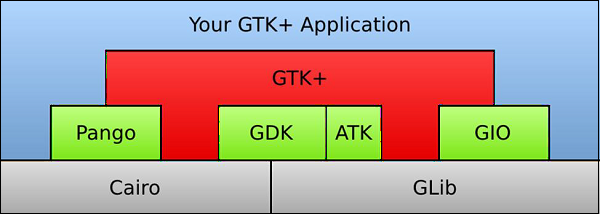
- PyGTK Tutorial
- PyGTK - Home
- PyGTK - Introduction
- PyGTK - Environment
- PyGTK - Hello World
- PyGTK - Important Classes
- PyGTK - Window Class
- PyGTK - Button Class
- PyGTK - Label CLass
- PyGTK - Entry Class
- PyGTK - Signal Handling
- PyGTK - Event Handling
- PyGTK - Containers
- PyGTK - Box Class
- PyGTK - ButtonBox Class
- PyGTK - Alignment Class
- PyGTK - EventBox Class
- PyGTK - Layout Class
- PyGTK - ComboBox Class
- PyGTK - ToggleButton Class
- PyGTK - CheckButton Class
- PyGTK - RadioButton Class
- PyGTK - MenuBar, Menu & MenuItem
- PyGTK - Toolbar Class
- PyGTK - Adjustment Class
- PyGTK - Range Class
- PyGTK - Scale Class
- PyGTK - Scrollbar Class
- PyGTK - Dialog Class
- PyGTK - MessageDialog Class
- PyGTK - AboutDialog Class
- PyGTK - Font Selection Dialog
- PyGTK - Color Selection Dialog
- PyGTK - File Chooser Dialog
- PyGTK - Notebook Class
- PyGTK - Frame Class
- PyGTK - AspectFrame Class
- PyGTK - TreeView Class
- PyGTK - Paned Class
- PyGTK - Statusbar Class
- PyGTK - ProgressBar Class
- PyGTK - Viewport Class
- PyGTK - Scrolledwindow Class
- PyGTK - Arrow Class
- PyGTK - Image Class
- PyGTK - DrawingArea Class
- PyGTK - SpinButton Class
- PyGTK - Calendar Class
- PyGTK - Clipboard Class
- PyGTK - Ruler Class
- PyGTK - Timeout
- PyGTK - Drag and Drop
- PyGTK Useful Resources
- PyGTK - Quick Guide
- PyGTK - Useful Resources
- PyGTK - Discussion
PyGTK - Introduction
PyGTK is a set of wrappers written in Python and C for GTK + GUI library. It is part of the GNOME project. It offers comprehensive tools for building desktop applications in Python. Python bindings for other popular GUI libraries are also available.
PyQt is a Python port of QT library. Our PyQt tutorial can be found here. Similarly, wxPython toolkit is Python binding for wxWidgets, another popular cross-platform GUI library. Our wxPython tutorial is available here.
GTK+, or the GIMP Toolkit, is a multi-platform toolkit for creating graphical user interfaces. Offering a complete set of widgets, GTK+ is suitable for projects ranging from small one-off tools to complete application suites.
GTK+ has been designed from the ground up to support a wide range of languages. PyGTK is a Python wrapper for GTK+.
GTK+ is built around the following four libraries −
Glib − A low-level core library that forms the basis of GTK+. It provides data structure handling for C.
Pango − A library for layout and rendering of text with an emphasis on internationalization.
Cairo − A library for 2D graphics with support for multiple output devices (including the X Window System, Win32)
ATK − A library for a set of interfaces providing accessibility tools such as screen readers, magnifiers, and alternative input devices.

PyGTK eases the process and helps you create programs with a graphical user interface using the Python programming language. The underlying GTK+ library provides all kinds of visual elements and utilities for it to develop full-featured applications for the GNOME Desktop. PyGTK is a cross-platform library. It is a free software distributed under the LGPL license.
PyGTK is built around GTK + 2.x. In order to build applications for GTK +3, PyGObject bindings are also available.